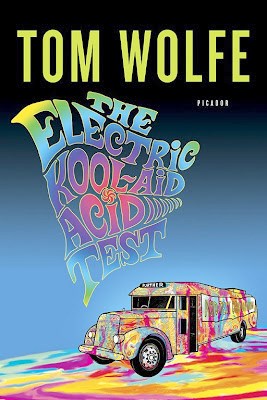One of the rallying cries of the 1960s counter-culture was “Don’t trust anyone over 30” but many of the writers, musicians, and artists that shaped the ideals and values of that era, were older than that even then. Just looking at some of the major writers of that era, we would now need to say “Don’t trust anyone older than 96.”
Jack Kerouac wanted to write like a jazz musician riffs on a phrase of music. If you want to decide for yourself how well he succeeded, the best place to start is with his bohemian classic On the Road. This lightly fictionalized stream-of-consciousness novel follows Sal Paradise (Kerouac) and Dean Moriarty (Kerouac’s idealized hero, Neal Cassady) in their travels around North America, and the people they meet.
Cassady also appears (under his own name) as one of Ken Kesey’s Merry Pranksters in Tom Wolfe’s The Electric Cool-aid Acid Test. The core of this seminal work of “New Journalism” covers the Pranksters’ trip from California to the 1964 World’s Fair in New York in a psychedelic school bus. Wolfe’s book used fictional techniques in reporting and rejected the notion that a reporter should be neutral and objective.
Kesey became most widely known as a pop culture icon but he started out as a writer. His first published novel, One flew over the Cuckoo’s Nest, was a huge success when it was released in 1962. The hero of the book is the convict Randle McMurphy, who feigns insanity so he can get transferred from a prison work farm to a psychiatric hospital. The rambunctious McMurphy creates havoc on the hospital ward and inspires his fellow patients to rebel against the harsh regime of Nurse Ratched.
If Wolfe was in many ways responsible for the rise of “New Journalism,” one critic suggested that its demise a decade later was due to its transformation to “Gonzo Journalism” by Hunter S. Thompson. It is undeniable that Thompson was guilty of freely inserting flagrantly absurd fiction in his later works but no one was funnier in attacking what he saw as hypocrisy and venality.
Thompson’s best-known book, Fear and Loathing in Las Vegas, is a surreal narrative loosely centred around going to Las Vegas on an assignment for Sports Illustrated to cover a desert motorcycle race. Instead of attending the race, Raoul Duke (Thompson) and “his attorney” consume massive amounts of drugs, wreck hotel rooms and cars, and have hallucinogenic visions in the desert. Embedded in all this craziness, Thompson laments the sorry end of the idealism of the 1960s counter-culture.
A Good Read is a column by Tri-City librarians that is published on Wednesdays. Michael DeKoven works as Port Moody Public Library.



